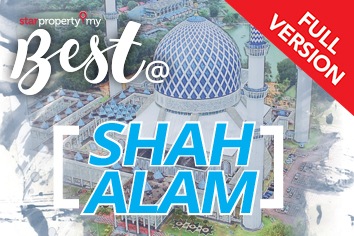Top developers come to town
27 Sep 2018

By Ng Pau Ling pauline@thestar.com.my Lifestyle estates enhance living quality and growth of Shah Alam t he landscape of Shah Alam is littered with different types of landed property in low-density housing arrangements.
According to the MBSA City Plan 2020, residential property developments account for 16.85% (5,108.47 ha) of the total land-use area of 30,310.72 ha in 2015, followed by industrial (10.35% or 3,135.9 ha), and commercial (3.05% or 923.51 ha).
The district has vast tracts of greenery, including 2,876.75 ha of forest, 1,238.58 ha of recreational land and 622.88 ha of golf courses.
Inhabited by 614,136 people in 2015, the population density is at 20 persons per hectare.
This low-density environment and peaceful surrounding have turned Shah Alam into one of the top picks of landed residential areas in the Klang Valley.
However, Shah Alam in its early years registered slow growth.
Housing prices in 1990 were between RM40,000 and RM150,000 per unit, according to an analysis of public housing development in Selangor by UKM senior lecturer Dr Junaidi Awang Besar.
“The earlier developments were focused in the central zone (Section 1 to 24) comprising mostly Malay Reserved Land with leasehold title, which can only be owned and held by Malays,” said Starhill Real Estate senior negotiator Zuraidah Ibrahim.
In the last two decades, the market began to see a rise in demand after the completion of several highways that opened up the area.
The maturing of central Shah Alam has also prompted developers to shift their focus and expand to the northern and southern regions.
New townships mushroomed, including Kota Kemuning by Gamuda Land (1994), Bukit Jelutong (1996) and City of Elmina (2013) by Sime Darby Property, Setia Alam by S P Setia (2004), and Eco Ardence by EcoWorld (2016).
“The freehold status and non-restricted use of lands in the northern and southern areas have created a bigger buyer market, attracting young families from a variety of backgrounds and making Shah Alam a vibrant city,” said MIP Properties senior negotiator Joseph Chan.
In the central zone, 90% of residents are Malays.
However, in southern and northern Shah Alam, especially in Setia Alam and Kota Kemuning, 70% of residents are non-bumiputra.
Besides spillover residents from neighbouring mature townships such as Subang Jaya, employees of Shah Alam’s factories and industrial parks also add to the source of residents in the district.
Landed properties make up the majority of Shah Alam’s housing market and are mainly owner-occupied, with terraced homes being the most sought after.
According to real estate advisors Landserve Sdn Bhd, prices of two-storey terraced houses in Shah Alam range from RM400,000 to RM1.45mil depending on the built-up area, location and tenure.
Chan of MIP Properties added that the landed property prices are 20% to 30% lower when compared to neighbouring areas, making Shah Alam an affordable option for buyers.
Mushrooming of lifestyle projects The gradual increase of property prices in Shah Alam over the last 20 years coincided with the entry of developers known for their strong financial backing and an appetite for massive projects.
“The new neighbourhoods of Bukit Jelutong, Setia Alam and Kota Kemuning predominantly cater to buyers from the medium to high-income segments,” noted Landserve managing director Chen King Hoaw. In 1996, the first phase of Bukit Jelutong’s 22×80 freehold double-storey terraced unit was sold at RM300,000.
The price has appreciated to RM850,000 today.
The lifestyle in Shah Alam has changed after developers brought in new design concepts to the city.
Lifestyle properties enhance the quality of life as well as ensure good capital growth in the long run.
“Township projects by developers such as EcoWorld, Gamuda Land and S P Setia now focus on four main pillars — security, wellness, lifestyle and landscape, for a conducive living,” said Chan.
EcoWorld is renowned for its lifestyle and landscape design that caters to the affluent.
Gamuda Land’s recent project in Kota Kemuning, twentyfive.7, offers lifestyle elements that are sought by Gen Y.
For Setia Alam, strong selling points are the international schools and Setia City Mall.
In 2003, terraced houses in Setia Alam were launched at RM250,000; the current transaction price starts at RM675,000.
The newest starter home series in the vicinity is priced from RM600,000.
Investment for rental return Besides landed property, Chen pointed out that affordable high-rise units including serviced apartments and condos located near higher learning centres and hypermarkets enjoy strong demand.
“The concepts of serviced apartment and SOHO (small office, home office) only came into the Shah Alam market over the past two decades,” he said.
“High-rise property in Shah Alam is priced between RM300,000 and RM750,000 a unit.
Investors generally focus on units located in Section 7 near UiTM and Section 13 near the MSU.” Section 13 also has three hypermarkets — Aeon, Giant and Tesco — located within a 2km radius.
They serve residents of Section 13 as well as meet the demands of neighbouring populations from Bukit Jelutong and central Shah Alam.
Industrial parks that offer job opportunities and a steady student population contribute to the strong rental demand in the area.
Also driving the housing market is the LRT3 project that connects Bandar Utama in Petaling Jaya to Bandar Parkland in Klang.
“With seven of its stations located in Shah Alam, LRT3 will increase rail connectivity between Shah Alam and many parts of the Klang Valley,” said Chen.
He is optimistic about Shah Alam’s prospects because the area has shopping, education, medical and recreational facilities that contribute to a dynamic working and living environment.
“The Shah Alam property market is healthy due to strong demand.
Property prices and rents are expected to remain stable, with upside potential in the near to medium term,” Chen added.
Challenges in the market The current rental market in Shah Alam is slow because of the variety of choices that are available.
The average monthly rental is between RM1,300 and RM1,500 while a fully-furnished unit can fetch up to RM1,800.
“With an average income of RM4,000, residents could go for a three-bedroom apartment,” said MIP Properties’ Chan, adding that any home with a rent above RM2,000 would likely be too costly.
He is also concerned about the stagnation of newly handed-over properties.
“Five years ago, these projects were launched at a higher ‘future price’ with the anticipation of facilities such as LRT3 and shopping mall.
“But after delivery of vacant possession, most of these facilities are still under construction,” he said.
The competitive pricing among sub-sale properties and attractive housing schemes offered by developers have further pressured the newly completed stocks as owners find it hard to sell their units or the selling price is not able to match the cost.
“I suggest the owner holds for another two or three years.
There will be a stronger housing demand once the infrastructure is in place,” added Chan.
Property prices and rental are expected to remain stable, with upside potential in the near to medium term.
– Chen.

